Mole, nevus, birthmark - all these are names of benign pigmented formations on the human skin. Moles can be present on the skin from birth or appear throughout life, be of various colors (from light brown to black), raised above the skin or be completely flat - no matter what the nevi are, they are safe until they begin to degenerate into melanoma - cancer skin. Black moles on the body are especially prone to such degeneration in the presence of favorable conditions.
Causes
The cause of the most common mole is an excess of melanin pigment in the skin, which leads to the growth of melanocyte cells, their concentration is called a nevus.
As for black moles on the body, there are many more reasons for the appearance of these formations.
Why moles darken:
- Direct exposure to sunlight. Ultraviolet radiation contributes to the appearance of both new birthmarks and a change in the color of existing ones, up to black.
- Changes in hormonal levels. Many black moles on the body may appear during pregnancy or during puberty.
- Systematic mechanical damage to the skin. This problem is typical for moles that are located in places that are constantly exposed to shaving and friction with clothing. It is recommended to remove such formations after consultation with a doctor.
- Hereditary factor. It is rare to see a mole on the body of a newborn. There is a version that they are simply negligible to be seen with the naked eye. But already at 2-3 years of life, nevi may appear on the child’s body. And if one of the parents has black moles on the body, the baby may also have them black.
- Bacterial or viral skin diseases.
- Exposure to x-rays or radiation.
If one of the black moles on the body has darkened even more for no reason, this is a reason to immediately contact an oncodermatologist.
Safe nevi
There are several classifications of moles, depending on the time of their appearance, color, size and appearance.
Black moles on the body are divided into:
- Flat. The most common formations do not cause concern if they are initially black. If the nevus has acquired a black color under the influence of any factors or for no reason at all, you must consult a doctor for diagnosis.
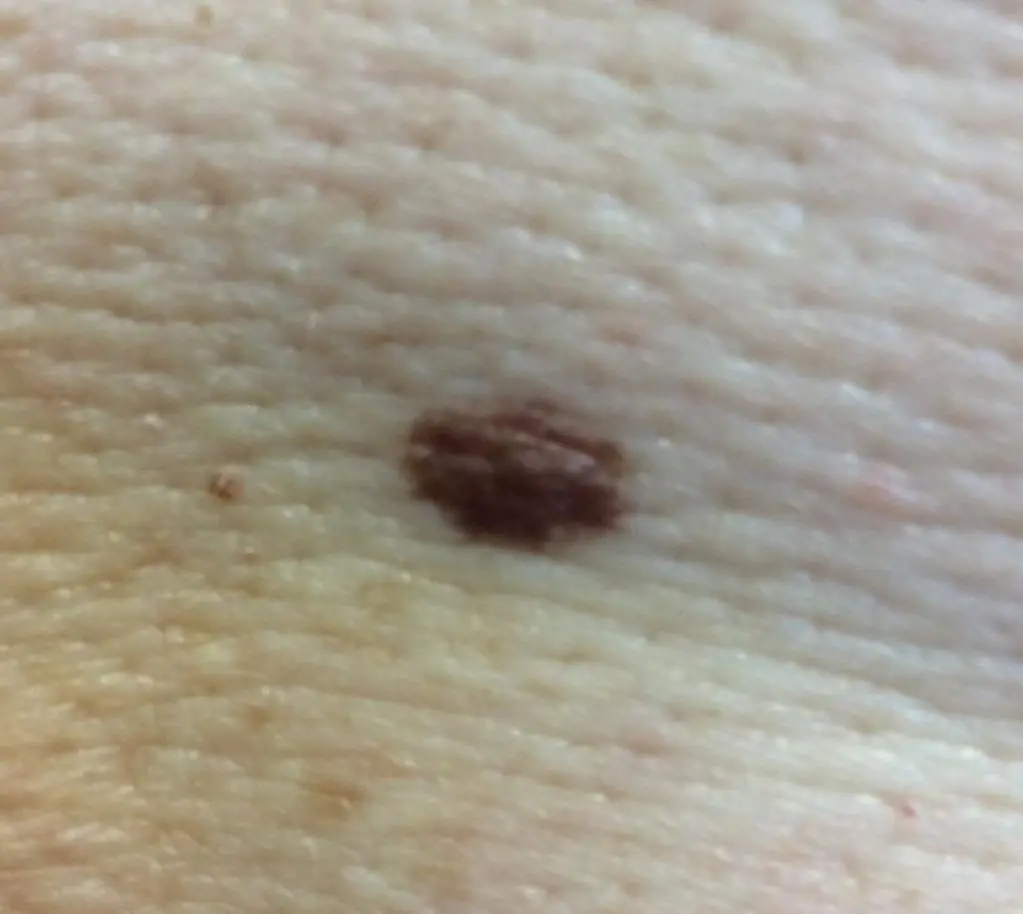
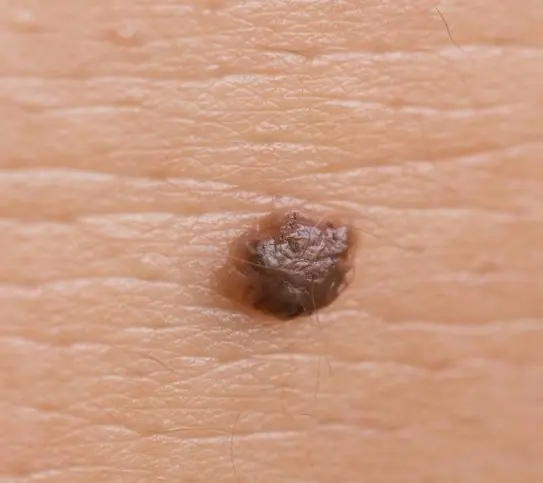
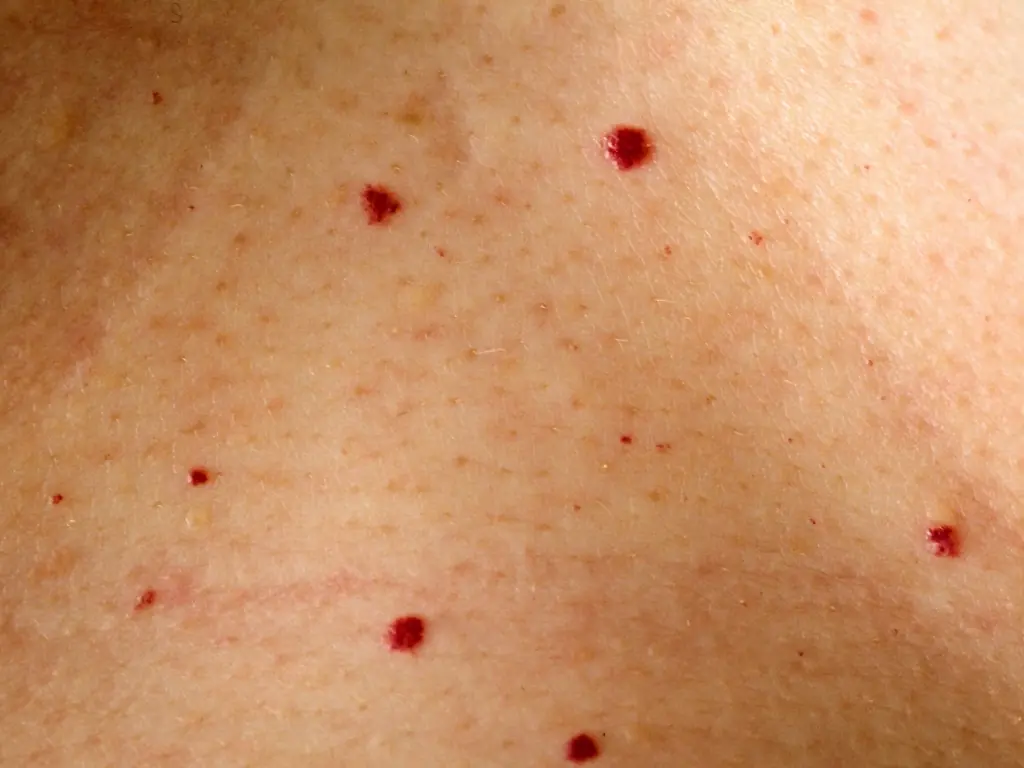

All of these moles are benign provided they have:
- diameter less than 0.5 cm;
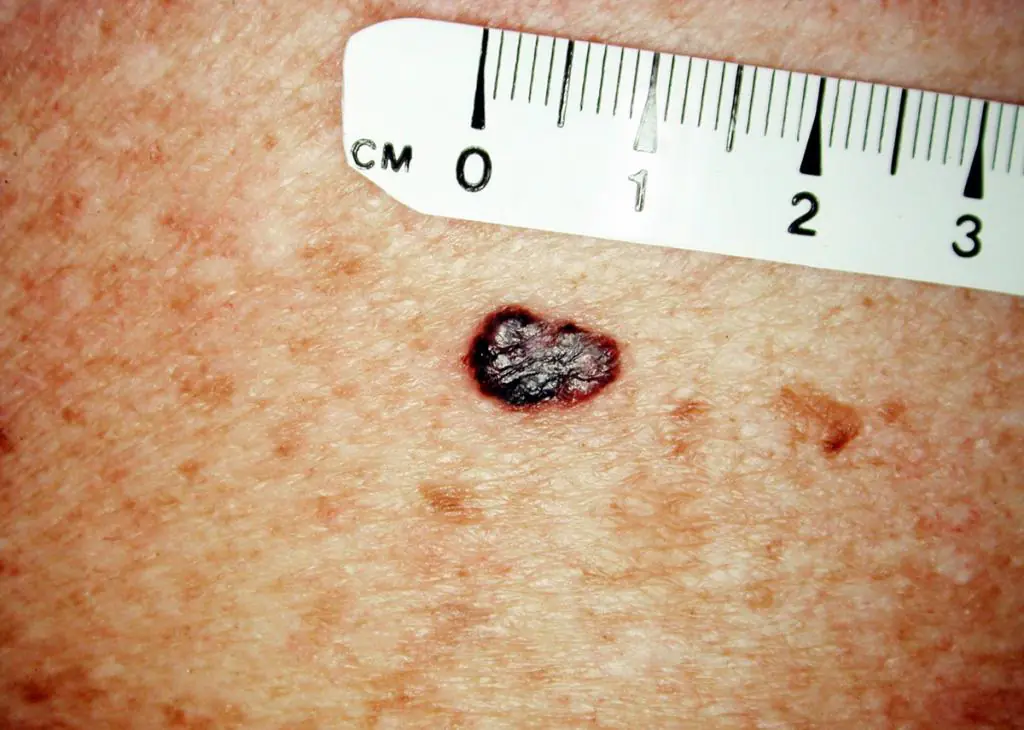
- clearly defined oval or round shape;
- smooth surface.
Any deviation from the norm, even one black mole on the body, is a reason to visit a medical facility.
Suspicious moles
In addition to ordinary moles that do not cause concern to their owner, there are several types of nevi that can be dangerous not only to health, but also to human life.
- Dysplastic moles - characterized by black color, large diameter (over 5 mm), uneven contours, uneven color, and may be convex.

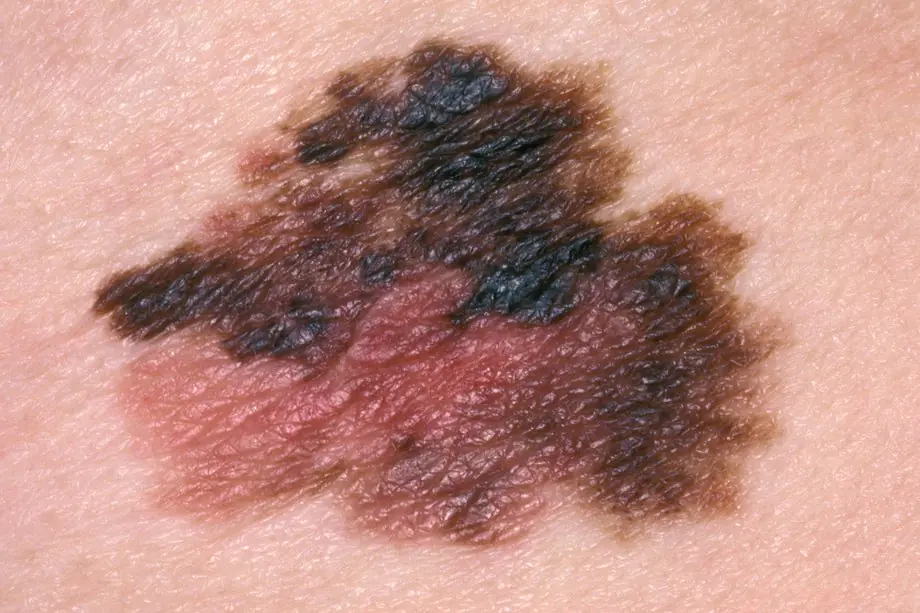
If there is the slightest suspicion of nevus degeneration, it must be remembered that early diagnosis of melanoma can save life.
Critical symptoms
Sometimes black moles on the body are located in such places that it can be difficult to independently assess their appearance. In such situations, other symptoms of a change in the mole should alert the owner.
Symptoms of nevus degeneration:
- bleeding from a mole;
- burning sensation, itching;
- loss of hair growing from the formation;
- the appearance of inflammation and ulcers;
- The surface of such a mole is rough to the touch, you can feel the scales.
Particular attention should be paid to moles that appeared after the age of 35.
Self-diagnosis methods
To make it easier for patients to remember what to pay attention to when observing nevi, doctors formulated the so-called FIGARO rule, which got its name from the first letters of 6 points that indicate a change in a mole.
- shape - the formation is raised above the level of the skin;
- change in the size of the nevus, noticeably accelerated growth rate;
- the boundaries of the mole are unclear;
- asymmetry - the 2 halves of the nevus differ from each other;
- size exceeds 0.5 cm;
- the color changes - multi-colored dots are added, and may become completely discolored.
To make it easier to track possible growth and changes in color of skin tumors, it is recommended to independently measure and record their diameter and take photographs.
Establishing diagnosis
If a black mole appears on the body, you cannot limit yourself to self-diagnosis. Considering the danger of melanoma, only a doctor can make a correct diagnosis and decide whether to remove a mole.
- interviewing the patient - the doctor needs to know whether the patient has been exposed to direct sunlight, whether there is a hereditary factor, what is his general condition;
- dermatoscopy - examination of skin tumors without surgical intervention;
- histology analysis - determining the presence of malignant cells in the formation;
- blood test for tumor markers;
- general blood and urine tests;
- biopsy - taking a sample of mole tissue for analysis.
If the degeneration of a mole into a malignant neoplasm is confirmed, other diagnostic methods (CT, MRI) are used to determine the stage of the disease, the activity of cancer cells, and the presence of metastases.
Treatment and observation
If the appearance of a black mole on the body poses a probable danger of the nevus to the life and health of the patient, the attending physician decides to remove the formation.
Mole removal methods:
- using liquid nitrogen, or cryodestruction - getting rid of pathological formations using ultra-low temperature;
- laser removal - gradual removal of pigmented tissues, the least traumatic method, often used on the face;
- electrocoagulation - electric cauterization, unlike laser, which is prohibited for dark skin, is suitable for any type of epidermis;
- excision with a radio knife, or radio wave method - the device does not contact the skin, leaving no traces;
- surgical removal - recommended only for malignant tumors, as it allows nearby tissue to be removed along with the melanoma to prevent relapse.
The method for removing a nevus is strictly individual and is selected by the attending physician based on the type of mole, the patient’s tests, the characteristics of his skin and the general state of health and immunity.
Risk group
There are groups of people who are especially susceptible to the degeneration of moles into malignant formations.
Risk groups include:
- people over 35 years of age who have new blackheads or moles on their body;
- patients whose number of moles exceeds 50, regardless of age;
- people with light skin, hair, eye color;
- owners of nevi susceptible to hereditary factors;
- people with weak immune systems.
To prevent the occurrence of melanoma, patients at risk are recommended to visit a dermatologist every 3 months, and for other owners of moles - annually.
Preventive measures
If a person has a tendency to form black spots on the body, similar to moles, it is especially important to adhere to the following recommendations to avoid their degeneration into oncology.
- Avoid exposure to direct sunlight, especially during the day when the sun is most active;
- do not visit the solarium;
- avoid mechanical damage to moles; if there are nevi in places of constant friction with clothing, razor trauma, it is recommended to remove such formations after consultation with a doctor;
- abandon synthetic materials that create a greenhouse effect and contribute to skin irritation;
- People with fair skin should avoid prolonged exposure to the sun, regardless of the time of day.
In addition to all of the above, treatment and removal of moles using traditional methods is prohibited. Self-medication can aggravate the problem and delay the moment of correct diagnosis and the start of life-saving therapy.
Moles on the human body can be of different shades: from light brown to deep black. Color depends on the amount of melanin (pigment substance) - the more of it, the darker the moles.
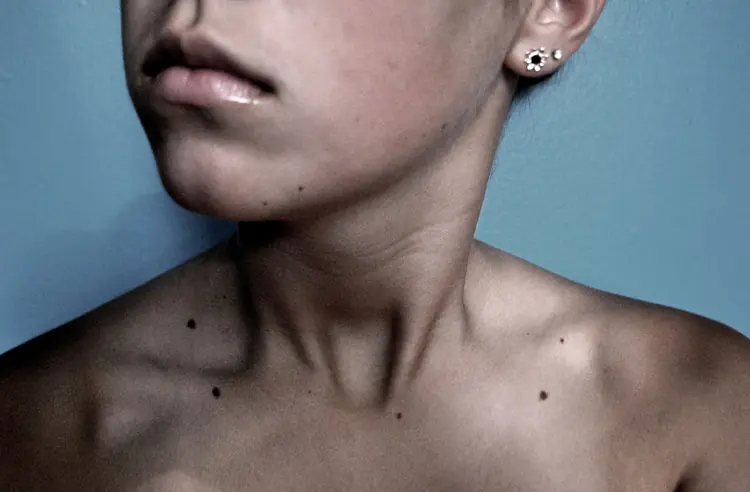
Photo 1. The color of a mole tells about its character. A black mole itself is not dangerous, but if it changes color, you should consult a doctor. Source: Flickr (Anastasia Catherine).
Causes of a black mole
The darkening of a mole to black is caused by the following factors:
- Ultraviolet. Exposure to direct sunlight causes an increase in melanin levels. Moles that are constantly exposed to ultraviolet radiation change color to a darker color;
- Hormonal changes. The restructuring that occurs in the body during adolescence, during pregnancy, during menopause, and endocrine disorders can contribute to a significant darkening of moles;
- Damage. Mechanical impact on the mole during shaving, scratching, washing with a hard washcloth, and even simple friction with tight clothing can damage the formation, which will begin to darken due to subcutaneous hemorrhages.
Note! If the mole is not completely blackened, but partially, this may indicate its degeneration. You should immediately consult a doctor, preferably an oncologist.
Are black moles dangerous?
Mole - benign formation. In both adults and children it comes in several types:
- Flat dark nevus. The most common type of moles. If the spot turns black or a red rim appears around it, this is a signal that can inform about an incipient pathology;
- Convex black mole. A black spot slightly raised above the surface of the skin alarms the owner, so such moles are usually closely monitored, noticing the slightest changes;
- Red-black nevus. It is less common than others and causes concern due to its appearance. Inhomogeneous color does not mean pathology. It is dangerous if a mole suddenly begins to change color: for example, it was reddish and became half black;
- Hanging black moles. Hanging moles should not be black. If the hanging nevus darkens, it means that it has been injured and blood has stopped flowing to it. The mole will gradually dry out and fall off. Experts advise removing dying moles in advance to avoid complications.
Black mole not dangerous, If:
- its diameter does not exceed 5 mm;
- it has clear outlines of an oval, a circle;
- the surface is smooth, repeating the skin pattern;
- the edges are clearly defined and not blurred.
Dangerous are:
- Dysplastic nevus. A black mole localized to any part of the body. Significantly increases the risk of developing melanoma. Signs: a flat mole larger than 5 mm in size, with unclear contours, asymmetrical, has several shades, the central part is raised;
- Melanoma. An ordinary mole that began to change: black, red, blue or white dots appeared, the formation began to resemble a hard lump. The nevus may become discolored, dry, rough, and painful.
We should be wary And nevi, formed after 35 years. Especially black ones, fast growing ones, with jagged edges. You need to undergo examination to avoid complications:
- bleeding moles;
- formation of nodules;
- dysfunction of internal organs: liver, kidneys;
- growth of metastases.
Treatment of a black mole
To understand whether a black mole needs treatment, you need to contact an oncologist.
Note! You should not trust the treatment of moles to a cosmetologist: only an oncologist can decide whether the formation is dangerous and whether it needs to be removed.
- dermatoscopy;
- lab tests;
- histological analysis.
If there are more than 40 nevi on the human body, it is advisable to draw up mole map. Based on it, it is easier for the doctor to guide the patient and monitor the growth and development of formations in the future.
Self-diagnosis is also useful - studying moles. Those on the back can be photographed with the help of relatives in order to notice changes in time.
If the oncologist insists on removing the nevus, then the diagnosis has shown possible degeneration. You can’t delay the operation: melanoma is one of the fastest growing forms of cancer.
A malignant black mole can only be removed surgically, using a scalpel. The method guarantees the complete elimination of pathological cells: tissues close to the nevus and those located in the deep layers of the epidermis are cut out. Other methods - cryodestruction (exposure to cold), laser and radio wave removal - are only suitable for eliminating benign moles.
After surgical removal, a wound remains at the site of the mole that needs to be treated to avoid infection:
- hydrogen peroxide;
- chlorhexidine;
- later - with external agents that prevent the formation of scars (contractubex).
There are also folk methods - cauterization with apple cider vinegar, celandine juice, milkweed, treatment with castor oil. Before using them, you should first consult with an experienced dermatologist.
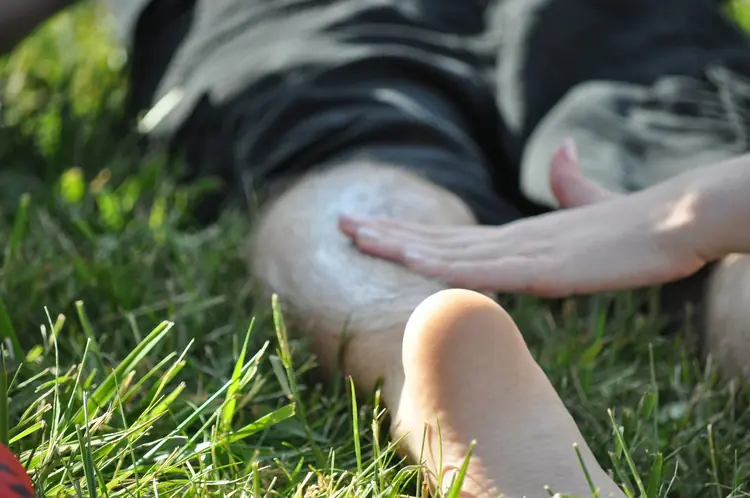
Photo 2. Sunscreens are a necessity of today. It is dangerous to be in the sun without them during the daytime. Source: Flickr (Lena Henry).
It is important! Self-medication of black moles is one of the reasons for complications and the transition of an ordinary nevus to a malignant one.
Prevention of malignancy
It is useful to take preventive measures not only for those who have many formations on their body, but also for those who have only a few of them:
- Sunbathe only in the morning and evening, when the sun is not as active as during the day.
- You cannot cover moles with a band-aid: the greenhouse effect contributes to the darkening of the birthmark and the penetration of infections.
- Fair-skinned people with a large number of moles should choose places where there is less sun to relax.
- Avoid visiting the solarium.
- Avoid injuring moles.
- Give preference to natural fabrics - they do not rub the skin or clog pores.
- Get checked regularly by a dermatologist. For those at risk - once every three months, for the rest - once a year.
Note! If changes in the condition of a black mole are noticeable even to the naked eye, this is a reason for urgent medical consultation.
It's rare to see a person without small dark marks on their body. Is it worth paying attention to these points? Only a doctor will distinguish between dangerous and normal moles - malignant melanoma or harmless nevus - and give recommendations on what to do with them. Is it worth worrying about the appearance of new formations, when immediate contact with specialists is required, what are the signs of cancer development - the answers to these questions remain to be found out. No one is immune from disaster, and early diagnosis will protect you from severe consequences.
What is a mole
The first tiny spots may appear in children in infancy. A mole is a small formation on the skin - a nevus - that is considered benign and harmless. The basis for their appearance is melanocyte cells that accumulate the natural pigment melanin. Depending on its quantity, a difference in color is observed. Available colors:
The shape of the tumors depends on the location and concentration of melanin. They may have a stalk or be located under the skin, be flat and convex. The most common type is round, but there are exceptions. The development of neoplasms is provoked by ultraviolet radiation - natural from the sun, in a solarium. Hereditary factors cannot be excluded. A common cause of growth is hormonal imbalance, characteristic of periods:
- puberty;
- pregnancy;
- menopause.
What types of moles are there?
One person may discover very different tumors. Types of moles are classified according to several criteria. This helps in correct diagnosis in case of changes. They differ in:
- origin– congenital, newly acquired;
- structure– pigment, vascular;
- place of education – in depth, on the surface, in the boundary layer;
- raised above the skin – flat – even, protruding as a hemisphere, pedunculated, larger birthmarks;
- potential threats – dangerous, degenerating into melanoma, non-dangerous.

Safe moles
Those who have dark spots on their skin should be wary of their changes. In time, detected signs of degeneration into melanoma contribute to the timely removal of the formation and preservation of health. Safe moles are different:
- the presence of a stalk – it cannot be formed by malignant cells that grow randomly;
- long-term condition without changes.
Spots that appear soon after birth are not considered dangerous. It is important that they are small in size. Good – non-dangerous – signs of neoplasms include:
- flesh tone;
- unchanged pattern of the skin of the nevus and adjacent tissues;
- soft consistency;
- hair on the surface of the neoplasm - growing from the skin, indicates the absence of pathologies;
- diameter no more than 5 mm;
- symmetry;
- nevus in the form of a spot.
Which moles are dangerous?
Why do people with nevi on their bodies need to monitor their changes? There is always a threat of degeneration of non-dangerous tumors into a cancerous tumor. What moles are dangerous to health? Key signs you need to know:
- change in shades towards the dark side, the appearance of multi-color;
- rapid increase in size - exceeds two millimeters per year;
- occurrence of cracks;
- the formation of asymmetry due to uneven growth;
- lack of elasticity;
- the appearance of itching, burning;
- presence of discomfort.
The appearance of dangerous moles requires an immediate visit to a specialist to clarify the nature of the changes and the likelihood of developing skin cancer. Pathological transformations provoke:
- injury to the nevus due to negligence;
- self-removal;
- abuse of exposure to the sun, use of a solarium;
- location of the formation in places of frequent contact with clothing - on the neck, head, genitals, legs;
- placement in the hair, on the face, palms - where there is a high probability of injury;
- previously removed melanoma.
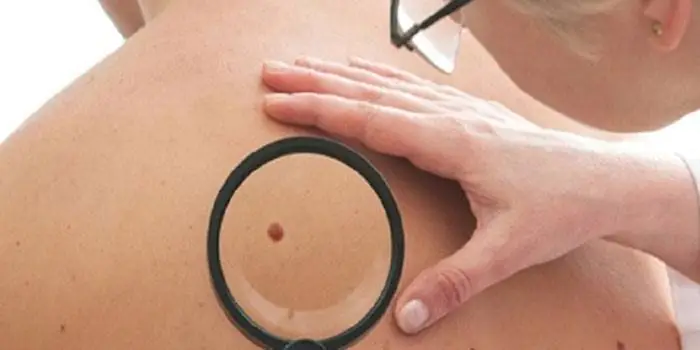
Why are moles dangerous?
Not a single person is protected from the sudden proliferation of cells of a harmless mole. Melanoma is an extremely serious disease. Changes not detected at the initial stage can result in death. The provoking factor is unsuccessful independent removal of tumors. Moles are dangerous because of their ability to:
- transform into an atypical – precancerous form;
- grow to large sizes;
- turn into cancerous;
- with minor external changes, metastases actively spread throughout the body through the circulatory and lymphatic channels.
How quickly does melanoma develop from a mole?
The transformation of a nevus into a cancerous formation can occur in different ways. The process depends on the stage of the disease and the type of tumor. Instant metastases are dangerous. Begins:
- growth of cancer (oncological) cells in the deep layers of the epidermis;
- their entry into the blood and lymph;
- penetration into the lungs, liver, kidneys;
- growth in these organs;
- complete damage to the body;
- death.
The growth phases of pigment cells are observed, along which melanoma develops from a mole. There are varieties:
- horizontal– damage to the upper layers of the skin occurs, lasting up to 10 years, but metastases do not appear;
- vertical– accompanied by the spread of cancer cells throughout the organs, can last two years, has an unfavorable prognosis;
- nodal – especially dangerous – characterized by deep spread within two months.
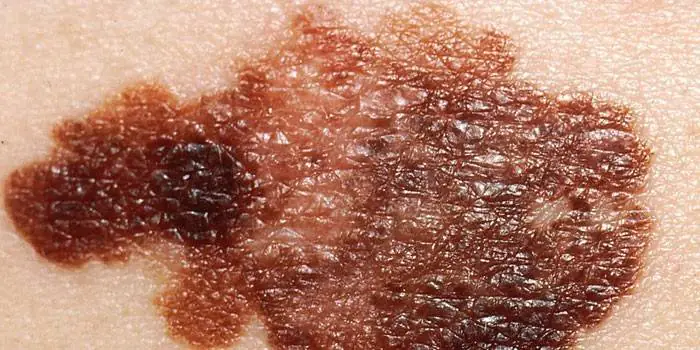
The first signs of melanoma
The patient can be assisted only when suspicious changes begin to be identified. The diagnosis, research, and referral for surgical treatment save a person’s life. The first signs of melanoma:
- increase in the height of the tumor;
- bleeding;
- the appearance of discharge;
- redness;
- burning, itching;
- swelling of tissues;
- softening of the nevus;
- the appearance of a crust;
- thickening;
- hair loss;
- expansion of pigmentation around the lesion.
With the further development of dangerous melanoma, the following are observed:
- significant change in size;
- the appearance of pain;
- enlarged lymph nodes;
- surface ulceration;
- formation of new foci;
- bleeding from places of pigmentation;
- liquid separation;
- skin thickening;
- the appearance of an earthy tint;
- signs of metastases are chronic cough, weight loss, cramps, headaches.
How to distinguish a mole from melanoma
To recognize which moles are dangerous and which are not dangerous, you need to know what they look like. A person with nevi, in order to avoid dire consequences, must constantly monitor the appearance of new formations and changes that occur. You can distinguish a mole from melanoma by its signs. Non-dangerous neoplasm:
- symmetrical;
- with smooth edges;
- uniform in color;
- with dimensions not exceeding 6 millimeters.
Features of dangerous melanoma that require seeking help from dermatologists:
- growth in a short time;
- pronounced asymmetry of shape;
- heterogeneity in color - the presence of inclusions of several shades;
- lack of clear boundaries - the contour line is blurred, jagged, and looks like a coastline on a geographical map;
- increased diameter over six millimeters;
- variability of any parameters - color, size, shape.
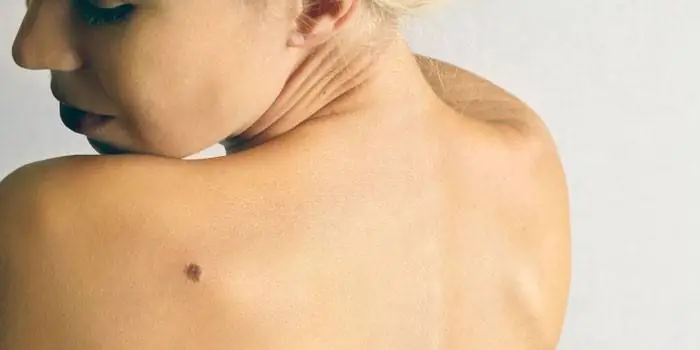
What dangerous moles look like
What do nevi that are subject to pathological changes look like? Only a doctor can correctly distinguish between non-dangerous tumors. Dangerous formations look like this:
- blue– compactions under the skin with clear boundaries, with dimensions no more than 10 mm;
- nodal– round, flat in shape, color – brown, black;
- cutaneous– often pale, convex;
- halo nevus – pigment surrounded by a light or white rim;
- spitz- looks like a dome-shaped tumor of pink shades, with the possible presence of a hole through which blood and liquid leak;
- connecting- connect individual entities into a whole.
Mole with jagged edges
One of the signs of a non-hazardous formation turning into a dangerous one is a change in contours. It often has blurred edges and scalloped borders. There are non-dangerous types of nevi - dysplastic. Only a specialist can make a correct diagnosis. A mole with uneven edges can be dangerous if there are additional signs of melanoma:
- accelerated changes in size;
- the presence of clearly defined asymmetry;
- the appearance of highly indented boundaries.
Rough mole
Such a neoplasm is harmless if its diameter is no more than 5 mm and remains constant in size. Often its appearance signals a lack of vitamins and nutritional disorders. Doctors advise coming for a consultation if it is discovered that:
- the smooth nevus turned into a rough one;
- bothered by burning, itching, tingling;
- irregularities and compactions appeared in the middle;
- areas with different shades formed;
- diameter has increased significantly.
A dangerous rough mole requires immediate examination if:
- the appearance of bleeding;
- development of the inflammatory process;
- rapid change in size;
- formation of asymmetry;
- formation of purulent discharge;
- the occurrence of painful sensations when touched;
- the emergence of an irregular shape, blurred boundaries, along the edges of the neoplasm.
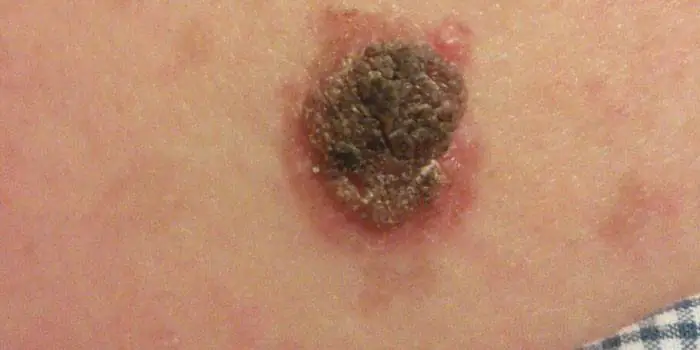
Large moles
Large formations on the skin are pigment spots. When they remain unchanged and do not cause inconvenience, this is not a dangerous phenomenon. It is important to constantly monitor their appearance, color, and size. To eliminate worries, you need to consult a dermatologist. During the visit, the specialist will conduct a diagnosis and give a forecast of the risk of developing a malignant neoplasm. Large moles become dangerous if they:
- injured;
- thickened;
- started to itch;
- were unsuccessfully removed independently;
- changed in size, shape;
- are bleeding.
What moles can be removed
Often nevi cause trouble for women when they are in a visible place - the face, neck. Even if they do not bother you, using removal will be the right decision - the appearance will improve significantly. After the procedure, the doctor must send the tissue for histological analysis to decide whether the mole is malignant or not. If the neoplasm is not dangerous, does not bother you, and does not change in size, surgery is not required. What moles cannot be removed? Experts believe:
- there are no contraindications;
- It is important to choose the right excision technique.
You should be careful about skin growths; it is unacceptable to remove them yourself. Only the doctor will determine whether a nevus is dangerous or not and decide what to do with it. You can delete it if:
- injured from clothing - on the neck, in the groin area, under the armpits;
- cause pain when touched;
- are located under the hair on the head and can be damaged when combing or cutting;
- change color, shape, outline;
- significantly increase in size;
- characterized by the presence of burning, itching;
- accompanied by inflammation and bleeding.



